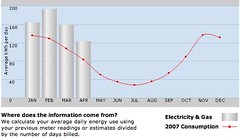
- Image by geofones via Flickr
At the 2010 Efficiency Vermont’s Better Buildings Conference, Andy Shapiro of Energy Balance and I offered an “Energy Challenge” to the audience of architects and building owners to begin a broad based campaign to track building energy performance. This challenge extends not only to collecting the data for your business or home, but also to publishing it so that we can begin to collectively learn where we stand and where we need to go.
Four Easy Steps
- Data Collection: building name, location, size (total conditioned sq.ft.) and 12 months energy usage from all sources (gas, oil, propane, electricity, cord wood, wood chips, wood pellets and renewables)
- Look at the Data: calculate total energy intensity based on 12 months of energy usage and building size (Btu/sq.ft./yr or kWh/sq.m./yr) and break the data down deeper looking at thermal (non-electric) intensity, heating only, the breakdown between renewables and non-renewables and differences between actual and estimated energy performance
- Benchmarking / Comparison to standard: use a national or local standard (such as the 2030 Challenge)1 to compare against and understand where you fall. Are you in the top 20%, the bottom 20%, or are you just about average?
- Publish the data, so you and others can begin to learn more!
Both the designers and owners of the building will see benefits from this process. Calculating these numbers will allow for a better understanding of how the building works and how to learn from it as an example for the future.
Benefits
- Designers and owners can see how actual energy performance compares to estimates.
- When estimated and actual performance is different, it will encourage owners and designers to investigate and correct potential deficiencies in design, construction, and/or operation so that performance is improved and energy costs are reduced.
- Owners will be able more effectively develop a financial plan for their future.
- Tracking over time will encourage continuous performance improvements.
- Building owners along with design and construction teams will be able to set energy performance targets based on real data and maintain them.
- When adopted broadly, this process will help our society to reduce its dependence on fossil fuels and increase its renewable energy independence by better understanding our energy intensity.
At Maclay Architects we have committed to the following practices, which we refer to as our Energy Pledge:
- We will estimate energy consumption for all of our projects.
- We will calculate total energy consumption from energy bills for all of our completed projects for at least the first year of operation (with owner approval).
- We will compare estimated with actual energy consumption for all of our projects.
- At the end of one year of tracking energy data, we will review the data with the building owner and offer suggestions for improvement when appropriate.
- After the first year, we will maintain cumulative owner energy data if desired by the owner and if the owner provides annual data.
- We will support efforts by others to expand this energy challenge so it will help reduce energy consumption in Vermont and beyond.
For additional information on how you can join the Energy Challenge or to request a simple template to begin doing your own energy calculations, just drop us a note here at the Net Zero Vermont blog, via the contact form.

1.Information on the 2030 Challenge and sample standards are available as a pdf file: http://www.architecture2030.org/downloads/2030_Challenge_Targets_National.pdf